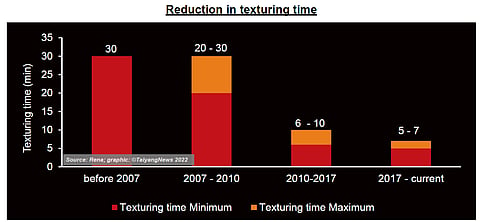

One of the key applications of wet benches in solar cell processing is texturing, which is typically combined with saw damage etching and accomplished in an integrated setup. While saw damage etch is a bit of an aggressive solution for removing the outer layer of silicon, texturing involves highly controlled etching. The aim of the texturing process is to realize a textured surface that reduces light reflection. In today's context, texturing means using alkaline chemistry as it is suitable for monocrystalline wafers. However, acidic solutions were also in use back when multicrystalline was in high-volume production, and at some point larger than mono, but now shrunk to a small niche and expected to face extinction soon. This difference in chemistry also influences the mode of operation. While alkaline processing is typically done in a batch sequence, acidic solutions enabling higher etching rates support an inline mode of operation (see Fundamentals Of PERC Cell Processing).
Looking back at the texturing process in PERC cell processing, the major improvements here took place in 3 areas –chemicals, bath lifetime and process time. On the chemicals front, one remarkable development is making the process isopropyl alcohol (IPA) free. The earlier practice was to add IPA to the texturing baths to enhance the lateral uniformity and anisotropic nature of the chemical process. But IPA makes the bath unstable, so does the process. As an alternative to IPA, all suppliers that are offering alkaline texturing solutions replaced IPA with moderating agents, usually called additives. IPA-free texturing has been an industry-wide standard for a few years already.
Improving the bath lifetime was another important development in alkaline texturing. The need to change the chemicals in such baths was about 5 to 10 runs until 2007, increasing to 30 runs by 2010, and the bath lifetime jumped to above 250 runs over the next 7 years. Some credit also goes to making the process IPA free, which also shortens the life of the bath (see Progress In Cell Production Equipment Segment).
The most significant improvement has been reduced texturing time. What was more than 30 minutes until 2007 was reduced to 20-30 minutes in the following 3 years, and further down to 6-10 minutes between 2010 and 2017. The current generation of texturing tools takes about 5-7 minutes. However, according to exateq's managing director Gerry Knoch, the optimal process time is more closer to 7 minutes.
While close to 5 minutes is possible, such a process will have limitations on the cleaning side. Knoch said, given that texturing is a batch process, reducing the texturing time also reduces the cleaning and rinsing time, thus lowering texturing time also affects the cleanliness of the wafer.
